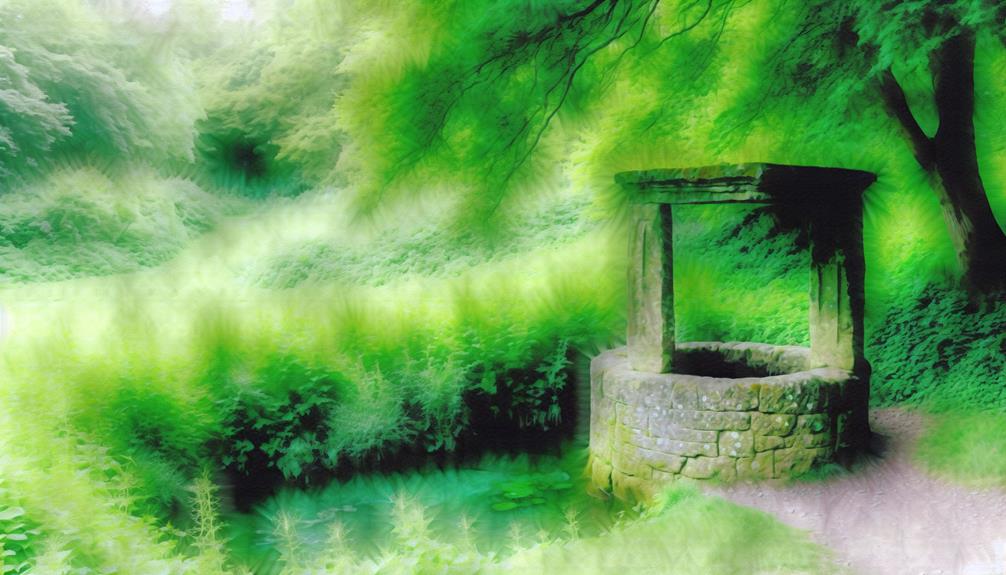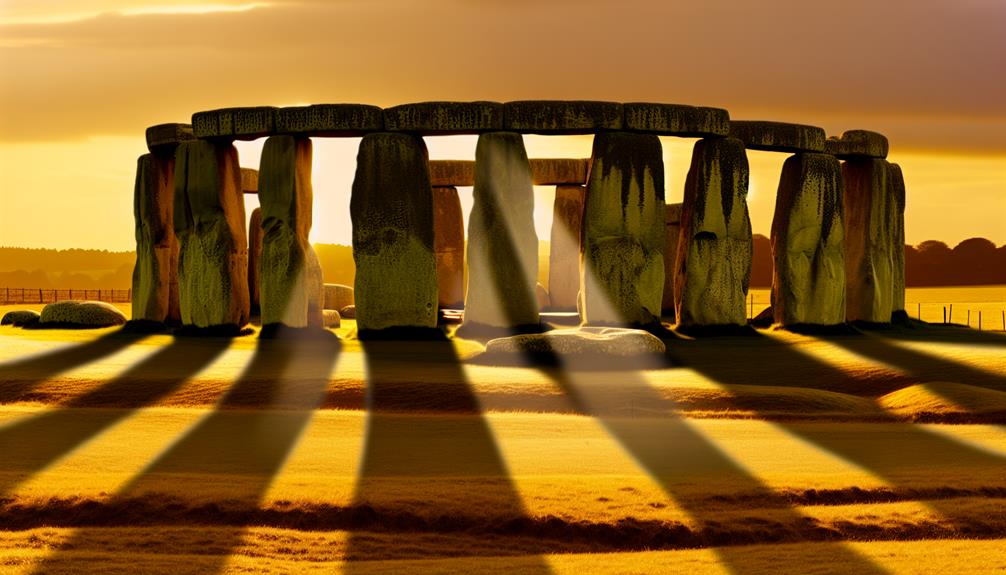Nestled amidst the enchanting British countryside, Glastonbury Well stands as a beacon of ancient spirituality and historical intrigue. Its waters are said to possess profound healing properties, attracting seekers of both solace and enlightenment. As tales of the Holy Grail swirl around this mystical site, it beckons visitors to unravel the mysteries that lie within its depths. The blend of folklore, archaeology, and spiritual practices makes Glastonbury Well an enthralling destination, where the past intertwines with the present in a tapestry of cultural significance and natural beauty.
Key Takeaways
- Glastonbury Well linked to earliest Christian sanctuary in Britain by Joseph of Arimathea.
- Surrounded by legends of the Holy Grail, attracting spiritual pilgrims seeking healing.
- Rich in mystical and restorative properties, offering purification rituals for visitors.
- Associated with Glastonbury Abbey, dating back to the 7th century.
- Located in Somerset County, near Glastonbury Tor, with crystal-clear water and lush greenery.
History of Glastonbury Well
Glastonbury Well in the United Kingdom holds a rich historical significance dating back centuries, intertwining with legends and religious beliefs. The well is steeped in historical significance, believed by many to be the site of the earliest Christian sanctuary in Britain, established by Joseph of Arimathea in the first century AD. This connection to Joseph of Arimathea has led to Glastonbury Well being associated with the legendary Holy Grail, adding to its cultural mystique.
Throughout history, Glastonbury Well has been a focal point for various cultural traditions. The well has been a place of pilgrimage for centuries, drawing people seeking spiritual healing and renewal. Its waters are believed to possess mystical and restorative properties, with visitors often partaking in rituals such as washing their faces or drinking the water as a form of purification. These traditions have been passed down through generations, contributing to the enduring allure of Glastonbury Well as a sacred site.
Moreover, the well's historical significance extends beyond its Christian associations. It has also been linked to Celtic mythology and Arthurian legend, further enriching its cultural tapestry. The blending of these different cultural threads at Glastonbury Well highlights its role as a place where history, myth, and tradition converge, offering a glimpse into the spiritual heritage of the United Kingdom.
Geographical Location and Surroundings
Nestled amidst the rolling hills of Somerset County in southwestern England, the location of Glastonbury Well offers a serene and picturesque setting. The well is situated near the mystical Glastonbury Tor, a conical hill that rises dramatically from the landscape. This area is known for its natural springs, with the well itself being a source of pure and crystal-clear water that has been revered for centuries.
Surrounded by lush greenery and ancient ruins, the well exudes an aura of mystery and tranquility. The ruins of Glastonbury Abbey, which date back to the 7th century, are nearby, adding to the historical significance of the area. Visitors to the well can explore the remains of this once-great monastery, adding a sense of awe and wonder to their experience.
The geographical location of Glastonbury Well also holds spiritual significance for many, as it is believed to be a place where the veil between the physical world and the spiritual dimension is thin. This belief has attracted pilgrims and seekers for generations, drawn by the energy and mystique of the surroundings.
Legends and Mythology Associated
The historical tapestry of Glastonbury Well is intricately woven with legends and mythology that have been passed down through generations, adding layers of mystique and wonder to this sacred site. The folklore tales surrounding Glastonbury Well are deeply rooted in the rich tapestry of British mythology, enchanting visitors and historians alike.
Here are some of the mythical creatures and folklore tales associated with Glastonbury Well:
- The Legend of King Arthur: Glastonbury has long been linked to the legend of King Arthur, with some claiming that the famous king was buried in the nearby Glastonbury Abbey. The mythical tales of Arthur and his knights add an air of mystery and magic to the already enchanting surroundings of Glastonbury Well.
- The Glastonbury Zodiac: According to folklore, the Glastonbury landscape is home to a giant Zodiac sign, with the well at its center. This mythical concept ties the well to the stars above, creating a sense of cosmic connection and spiritual significance.
- The Glastonbury Dragon: Legend has it that a fearsome dragon once roamed the lands around Glastonbury, terrorizing the locals until it was defeated by a brave knight. The tale of the Glastonbury Dragon adds an element of danger and adventure to the folklore surrounding the well.
- The Lady of the Lake: Another famous legend associated with Glastonbury Well is that of the Lady of the Lake, who is said to have gifted King Arthur his legendary sword, Excalibur. This mystical tale adds a touch of feminine power and magic to the myths surrounding the well.
Archaeological Discoveries
Numerous significant archaeological discoveries have shed light on the historical importance and cultural significance of the site surrounding Glastonbury Well in the UK. Excavations in the area have unearthed a treasure trove of ancient artifacts dating back centuries, providing valuable insights into the lives of those who once inhabited this land. Among the excavation findings are pottery fragments, tools, and human remains, all of which offer clues to the daily activities and burial practices of the early inhabitants of the region.
One of the most notable discoveries at Glastonbury Well is the uncovering of a series of ancient structures that point to the presence of a settlement or religious site. The layout and design of these structures suggest a sophisticated level of planning and construction, indicating a thriving community at the site. Additionally, the discovery of ritual objects and offerings further underscores the spiritual significance of the area.
The excavation findings at Glastonbury Well have not only provided valuable information about the past but have also sparked intrigue and curiosity about the historical development of the site. As archaeologists continue to uncover more clues and artifacts, the story of Glastonbury Well unfolds, offering a glimpse into the rich tapestry of history and culture that has shaped this mystical place.
Spiritual Significance and Practices
Excavations at Glastonbury Well have revealed not only a wealth of archaeological artifacts but also indications of the site's spiritual significance through the discovery of ritual objects and structures hinting at religious practices. The spiritual significance of Glastonbury Well is deeply rooted in history, attracting individuals seeking spiritual enlightenment and connection to higher powers.
Here are some key aspects that shed light on the spiritual practices associated with Glastonbury Well:
- Sacred Ritual Objects: Archaeologists unearthed various sacred objects like amulets, figurines, and offerings, suggesting the performance of rituals and ceremonies at the site.
- Meditation Practices: The tranquil and serene environment surrounding Glastonbury Well makes it an ideal place for meditation. Visitors often engage in meditation to seek inner peace and spiritual rejuvenation.
- Ancient Spiritual Ceremonies: Historical records and artifacts indicate that ancient civilizations conducted elaborate spiritual ceremonies at the well, invoking spiritual beings and energies.
- Pilgrimages and Offerings: Throughout history, pilgrims have journeyed to Glastonbury Well to make offerings, seek blessings, and partake in spiritual practices to enhance their connection with the divine.
These spiritual practices and ceremonies form an integral part of the mystical aura that surrounds Glastonbury Well, making it a sacred site for those seeking spiritual solace and enlightenment.
Modern-Day Visitors and Pilgrimages
In contemporary times, Glastonbury Well continues to attract a diverse array of visitors and pilgrims seeking spiritual experiences and connections. The well, steeped in history and legend, serves as a focal point for individuals from various walks of life, drawn to its mystical allure and reputed healing properties. Modern-day visitors engage in a range of cultural experiences, immersing themselves in the rich tapestry of traditions that have evolved around the well over centuries.
Pilgrims journey to Glastonbury Well not only to explore contemporary rituals but also to explore the well's deep-rooted spiritual significance. They seek solace, enlightenment, and a sense of belonging in a world often fraught with uncertainty. The well has become a hub for spiritual tourism, attracting individuals keen on experiencing ancient practices and connecting with something greater than themselves.
Through their pilgrimages, visitors gain unique insights into the historical and cultural contexts that have shaped Glastonbury Well into the revered site it is today. They participate in rituals, ceremonies, and meditative practices that serve to deepen their understanding of the well's enduring importance. These experiences offer a profound sense of connection to both the past and the present, fostering a renewed appreciation for the spiritual heritage that permeates Glastonbury Well.
Conservation Efforts and Preservation
Amidst the ongoing influx of modern-day visitors and pilgrims drawn to Glastonbury Well for its spiritual allure and historical significance, the imperative to safeguard and preserve this sacred site through dedicated conservation efforts has gained paramount importance. Ensuring the environmental sustainability of the well while actively involving the local community in preservation initiatives is essential to maintaining the sanctity of this ancient site.
- Environmental Sustainability: Conservation efforts at Glastonbury Well focus on promoting practices that minimize the environmental impact of visitors while protecting the natural surroundings. Initiatives such as waste management, sustainable water usage, and biodiversity conservation play a crucial role in preserving the ecological balance of the site.
- Community Involvement: Engaging the local community in conservation activities fosters a sense of ownership and responsibility towards Glastonbury Well. Collaborative efforts, such as volunteer programs, educational workshops, and community clean-up days, not only contribute to the preservation of the site but also strengthen social bonds within the community.
- Heritage Protection: Recognizing the cultural significance of Glastonbury Well, conservation efforts also aim to protect the historical heritage associated with the site. Preservation of ancient structures, artefacts, and rituals ensures that the rich cultural legacy of the well is passed down to future generations.
- Cultural Significance: Glastonbury Well holds immense cultural significance as a symbol of spiritual pilgrimage and historical reverence. By preserving the traditions, stories, and rituals connected to the well, conservation efforts help maintain the spiritual essence and cultural identity of this sacred site.
Well's Healing Properties and Beliefs
The belief in Glastonbury Well's healing properties has been deeply ingrained in the cultural and spiritual fabric surrounding this ancient site. For centuries, visitors have been drawn to the well not only for its historical significance but also for the perceived therapeutic benefits it offers. The healing properties associated with Glastonbury Well are intertwined with a rich tapestry of folklore traditions and spiritual practices.
Healing rituals performed at Glastonbury Well often involve the use of the water from the well itself. This water is believed to possess unique qualities that can aid in physical, emotional, and spiritual healing. People partake in these rituals with a sense of reverence and respect for the ancient traditions that have been passed down through generations.
Folklore traditions surrounding Glastonbury Well speak of miraculous cures and transformative experiences that have taken place at the site. Stories of pilgrims being healed of ailments after visiting the well have contributed to its reputation as a place of healing and renewal.
Visitors to Glastonbury Well are not only seeking physical healing but also a connection to something greater than themselves. The belief in the well's healing properties serves as a beacon of hope and comfort for those who come in search of solace and restoration.
Events and Festivals at Glastonbury Well
Events and festivals held at Glastonbury Well offer a diverse array of cultural and spiritual experiences that attract visitors from all corners of the globe. These events are not only a celebration of music festivals but also serve as cultural gatherings that enrich the soul and connect individuals in a shared experience. Here are some key highlights of the events and festivals at Glastonbury Well:
- Glastonbury Festival: The most renowned music festival held at Glastonbury Well, attracting thousands of music enthusiasts annually. It features a lineup of world-class artists across various genres, creating a vibrant and immersive musical experience.
- Beltane Celebrations: A cultural gathering that honors the ancient Celtic festival of Beltane, marking the beginning of summer. Visitors can participate in traditional rituals, music, and dance performances that pay homage to nature and the changing seasons.
- Mystical Healing Retreats: These retreats offer visitors a chance to rejuvenate their mind, body, and spirit in the tranquil surroundings of Glastonbury Well. Participants engage in yoga sessions, meditation practices, and holistic healing treatments guided by experienced practitioners.
- Folklore and Mythology Workshops: Explore the rich history and legends surrounding Glastonbury Well through interactive workshops and storytelling sessions. Participants learn about the mystical significance of the well in folklore and its connections to Arthurian legends, enhancing their understanding of the site's cultural heritage.
Frequently Asked Questions
How Deep Is the Water in Glastonbury Well?
The depth measurement of water bodies is essential for various reasons, including understanding aquatic ecosystems and water resource management.
Determinating the depth of water sources like wells provides valuable insights into water availability and quality. Additionally, water clarity, often evaluated alongside depth measurement, indicates the level of impurities or sedimentation present in the water.
This data aids in evaluating the overall health and usability of the water source.
Are There Any Restrictions on Visiting the Well?
When considering a site of cultural significance, it is common to encounter restrictions on visiting, often aimed at preserving the historical integrity of the location. These restrictions can vary depending on the importance of the site, with some places implementing limited access or specific guidelines for visitors.
Understanding and respecting these restrictions is essential in order to maintain the authenticity and value of such culturally significant sites.
Can Visitors Swim or Bathe in the Well?
Swimming in natural springs has long been associated with potential health benefits due to the healing properties of mineral-rich waters.
However, it is crucial to take into account any regulations or guidelines in place to safeguard the well-being of visitors and the preservation of the site.
Before engaging in swimming or bathing activities in any natural body of water, it is advisable to research local rules, safety measures, and environmental concerns to make informed decisions.
Is There a Specific Time of Day When the Well Is Most Visited?
Peak hours at popular sites are influenced by various factors, including visitor behavior, tourist demographics, and cultural significance. Understanding these elements helps in identifying specific times when the site is most visited.
Are There Any Local Superstitions or Taboos Related to the Well?
Local beliefs and traditions often shape the cultural significance of wells around the world. These beliefs can range from superstitions about the well's healing powers to the practice of making ritual offerings to appease spirits or seek blessings.
Understanding these local customs and taboos is crucial to respecting the cultural heritage associated with these sites and the communities that hold them sacred.
Conclusion
To sum up, Glastonbury Well stands as a mystical sanctuary steeped in history and legend, offering solace and spiritual renewal to all who seek it.
The tranquil surroundings, rich cultural heritage, and healing properties of the well create a tapestry of wonder and intrigue that continues to captivate visitors.
As the sun sets over this ancient site, one cannot help but feel the echoes of the past whispering through the lush greenery, inviting all to partake in its sacred mysteries.


